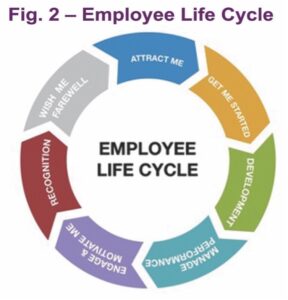How Does the Employee Lifecycle Factor into Your HR Strategy?
As a refresher, an HR Strategy is a system that is developed outlining human resource practices for a specific job or even a collection of positions, specifically aimed at developing and drawing out the best employee performance possible, to meet the organization’s ultimate goals. When developing your organization’s HR Strategy, it is important to remember that these strategies are meant to be used in selection as well as managing your teams through their lifecycle.
Employee Lifecycle
The employee life cycle (see Figure 2 below) is a human resources model that identifies stages in employees’ careers to help guide their performance management and optimize associated processes. Organizations address some of these stages effectively and others are reevaluated to provide a more integrated process. By integrating and analyzing disparate pieces of data, the organization can develop a deep understanding of an employee’s journey at work. Over time, the results will help the organization to ensure that their talent management strategies and their human resource management practices will meet the needs of an increasingly complex workforce.

An important deciding factor in an organization’s success is the quality of the people – from individual contributors to managers to executives. There are usually ad-hoc methods and different tools used for selection, development, and other elements supporting the employee with no overall system to coordinate or communicate effectively and track the employee lifecycle path. Therefore, it lacks context or a common method to communicate information to employees and leaders who want to support them effectively.
Recruitment and Selection
The employee lifecycle starts before the employee is hired. Branding, recruiting, and selection go hand in hand to find the right talent and a good job fit for the person and the hiring company. There is a proven solution available from Reveal to help with selection. In addition, the assessment and reports can be used to develop a proprietary process for Executive or Senior level management employees.
Some of the tactical functions of HR must be in place to provide a successful recruiting strategy. Those include things such as a job description, an understanding of the roles and responsibilities, a compensation and benefits package per job function and an onboarding plan once they are hired. So then, how can assessments like Reveal support you in coaching throughout your employees’ lifecycle?
How Can Reveal Support Your HR Strategy
Using the Reveal assessment to collect and maintain data on employees that can be used for various purposes, creates an unshakable foundation that your HR Strategy can be built upon. Using the Reveal report to support the employee lifecycle for your candidate’s enables you to take Reveal beyond the hiring phase and into coaching, succession planning, and so forth.
It is important to remember that the key to having quality people at any level, is to put a system in place that stays relevant through the entire employee lifecycle. The objective is to have Reveal or whatever assessment tool you are using currently, as part of the system… but it cannot BE the system. It is a matter of finding leverage points along the employee life cycle that HR can begin to influence and make a difference across the enterprise. Reveal can certainly help with that process.
If you are interested in learning more about how Reveal can work for you, click here to contact us or schedule a 15-min discovery call.

